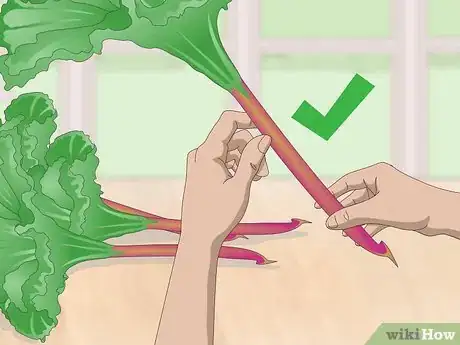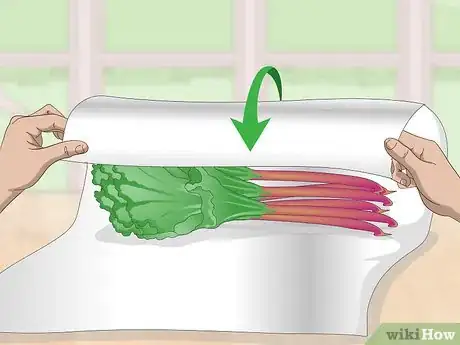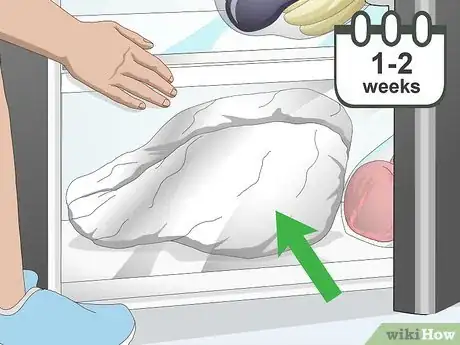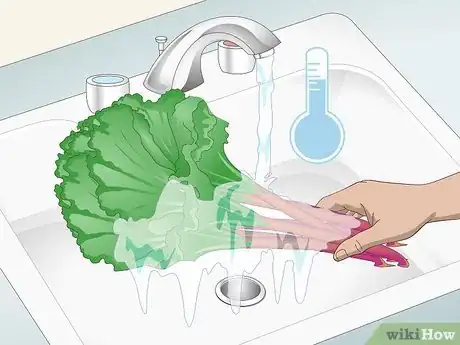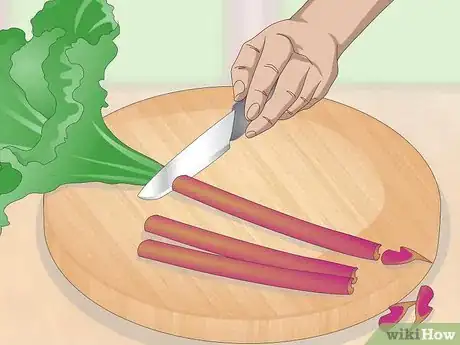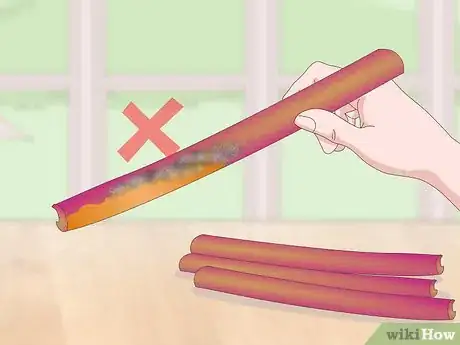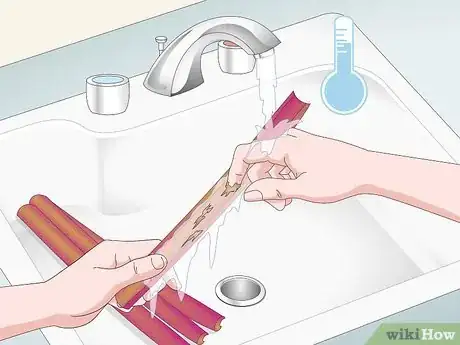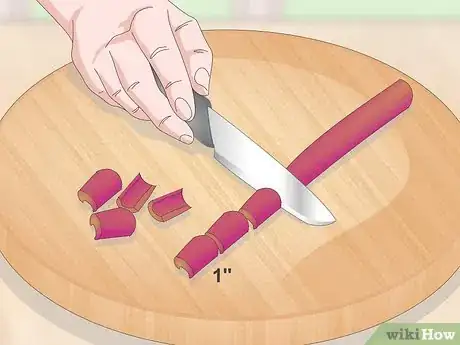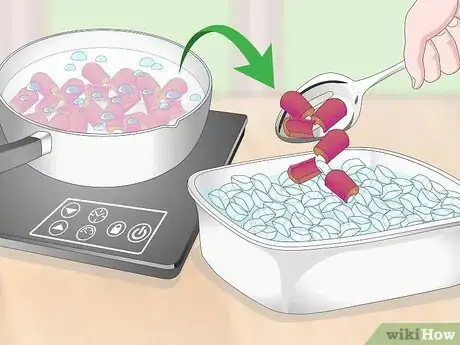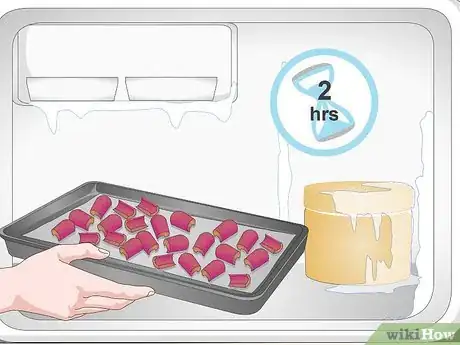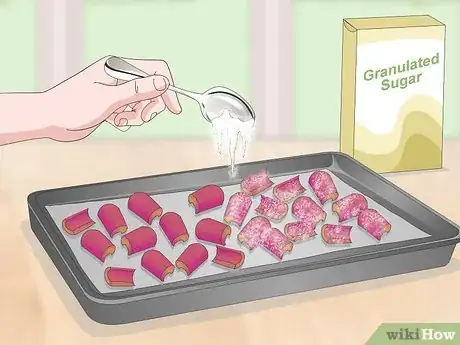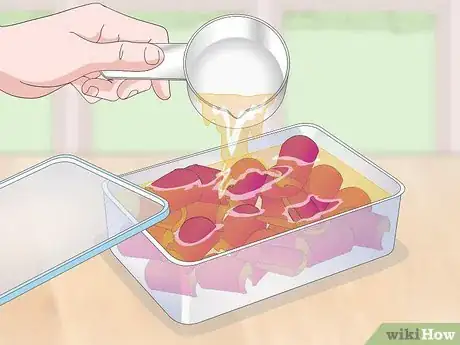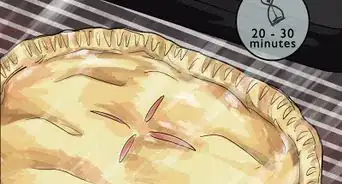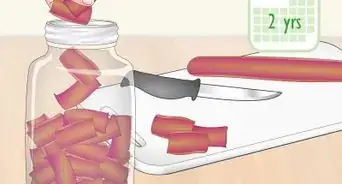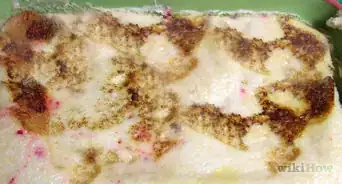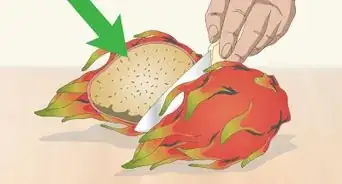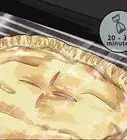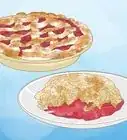This article was co-authored by wikiHow Staff. Our trained team of editors and researchers validate articles for accuracy and comprehensiveness. wikiHow's Content Management Team carefully monitors the work from our editorial staff to ensure that each article is backed by trusted research and meets our high quality standards.
This article has been viewed 18,347 times.
Learn more...
The tartness of rhubarb is often used to balance the sweet flavor of sauces, jams, and pastries. Since these red and green stalks are often sold in bundles, you may wind up with more than you need for your recipe. Instead of just discarding the extra rhubarb, consider storing it in the refrigerator or freezer, and using it later. Wrap the rhubarb in aluminum foil and store it in the crisper drawer of your refrigerator for 1-2 weeks. Or freeze the washed and cut stalks for 9 months. Then, consider adding some sugar or a simple syrup to help preserve it long-term.
Steps
Keeping Rhubarb in the Refrigerator
-
1Check each stalk of rhubarb for discoloration or other signs of rotting. The rhubarb should be firm and have a bright red or green coloring. Specifically look for soft or black spots, as this is a sign that the rhubarb is starting to rot.[1]
- Discard any rhubarb that is largely discolored or that has an off-putting smell. Cut away small-discolored parts to help preserve the rest of the stalk.
- Remove any fibers from the stalks as you preserve them, as these could be hiding discolored spots.
-
2Wrap the rhubarb stalks in aluminum foil to preserve the texture and flavor. Cut a piece of foil that is at least twice as wide as your bundle of rhubarb, and 1–2 in (2.5–5.1 cm) longer than the stalks. Then, rest the foil on a flat surface and place your bundle of rhubarb in the center of it. Carefully, fold the edges of the foil around the rhubarb until it is completely covered.[2]
- Do not overly crumple the ends of the foil, as this will prevent the ethylene gas produced by the rhubarb from escaping. Ethylene gas will soften your rhubarb quickly.
- It is recommended to use foil over plastic bags or plastic wrap when storing rhubarb in the refrigerator. The foil will allow rhubarb to aerate enough to keep it crisp, and it is durable enough to keep the rhubarb from drying out.
Advertisement -
3Store the rhubarb in the crisper drawer of your refrigerator for 1-2 weeks. Place the rhubarb in the crisper drawer of your refrigerator to keep it fresh and help prevent it from drying out. Avoid resting any heavy or bulky items on top of the rhubarb as this could cause bruising or black spots on the vegetable.[3]
-
4Wash the rhubarb under cold water when you are ready to use it. Use your fingers or a produce scrub brush to remove any dirt or grime from the stalks. Then, pat the rhubarb dry with a paper towel or a clean cloth.[4]
- Make sure that the rhubarb is completely dry before attempting to cut it. Excess water can make the exterior of the rhubarb slippery and difficult to handle.
-
5Use a sharp knife to trim the leaves and bottom of the stalk. Start by removing the top leafy part of the stalk, and discard it. Then, trim about 1⁄2 in (1.3 cm) off the bottom of the stalk to remove the tough and most likely browned base.[5]
- Continue to cut the rhubarb as needed for your particular recipe.
- Do not eat or cook any leaves on the rhubarb stalks. The leaves contain a toxin called oxalic acid.[6]
Freezing Rhubarb
-
1Examine each rhubarb stalk for discoloration or rotting spots. Check to make sure that each stalk is firm with a bright red or green color. Look for black or soft spots along the stalk. Either cut off small rotting spots or throw away the entire stalk if it appears too discolored. You do not want to store potentially rotting rhubarb.[7]
- If there are fibers attached to the stalks, remove them as you are checking them over.
-
2Wash the rhubarb under cold water to remove any dirt and dry it thoroughly. Use your fingers or a produce scrub brush to gently rub off any dirt or grime on the rhubarb stalks. Then, dry each stalk with a paper towel or a clean cloth.[8]
- Make sure that the rhubarb is completely dry before attempting to cut it, as excess water can make the exterior hard to handle.
-
3Use a sharp knife to cut each stalk of rhubarb into 1 in (2.5 cm) pieces. Place one of the rhubarb stalks onto a cutting board. If needed, cut off and discard any leafy ends and the bottom 1⁄2 in (1.3 cm) of the stalk. Then, carefully cut the stalk into pieces that are approximately 1 in (2.5 cm) long.[9]
- Do not eat any leaves on the rhubarb stalk. The leaves contain toxic oxalic acid.[10]
-
4Consider preserving the color and flavor of the rhubarb by blanching it. If you are planning on freezing it for a period longer than 3 months, consider blanching the pieces of rhubarb. You can still freeze the rhubarb even if you do not blanch it, but this process will better help preserve the vegetable.[11]
- Place the cut rhubarb into a pot with boiling water. Allow the rhubarb to boil for 1 minute. Then, carefully drain the pot over the sink and into a colander.
- Set the colander into an ice bath for 1-2 minutes. This will prevent the rhubarb from continuing to cook. Then, lift the colander to drain it.
- Lay out the rhubarb on a paper towel or a clean cloth and dry it.
-
5Flash freeze the rhubarb on a lined baking sheet for 2 hours. Line a baking sheet with parchment paper. Arrange the rhubarb pieces so they are a single layer. Then, place the filled sheet in the freezer for 2 hours to flash freeze the rhubarb. Flash freezing the rhubarb pieces will keep them from sticking together when storing long-term in a freezer bag or container.[12]
- If you do not have parchment paper to line the baking sheet, use plastic wrap instead.
- Use a second lined baking sheet if you have more rhubarb than you can fit on a single baking sheet.
- Check on the rhubarb after the first hour to make sure the pan did not buckle under the temperature change, and that the pieces are freezing properly.
-
6Toss the partially frozen rhubarb with granulated sugar to sweeten it. Coat the rhubarb pieces with sugar to help preserve the texture and sweeten it. This is not necessary to do if you do not want your rhubarb sweetened with sugar.[13]
- For every 4 cups (400 g) of rhubarb, mix it with 1 cup (200 g) of granulated sugar.
- Use a spoon to toss the rhubarb with the sugar until the pieces are evenly coated.
-
7Put the frozen rhubarb pieces into a sealable container or freezer bag. Leave approximately 1⁄2–1 in (1.3–2.5 cm) of headspace inside of each filled container or freezer bag. This will account for the expansion of the rhubarb while it finishes freezing. Then, seal each container or bag properly before freezing.[14]
- Do not put the rhubarb into a freezer bag if you are planning to add a simple syrup.
-
8Submerge the rhubarb in a simple syrup to retain the texture and flavor. If you are planning to use this tart vegetable in a dessert, then consider freezing it in a simple syrup. The syrup will help the rhubarb retain its texture, and will add a sweetened taste to help cut its tartness. Further flavor the simple syrup with your favorite fruit juice, like apple, peach, or grape juice.[15]
- For a light simple syrup, combine 4 cups (950 mL) of water or fruit juice and 2 cups (400 g) of granulated sugar into a saucepan. Add more sugar if you want a thicker, sweeter syrup.
- Bring the sugar and water to a boil and constantly stir it until the sugar is completely dissolved.
- Pour the simple syrup into a heat-resistant container and place it in the refrigerator to chill for 30 minutes or until it is cool.
- Add 1⁄2 cup (120 mL) of the simple syrup to the container with the chopped rhubarb. Add more of the syrup if needed to completely submerge the rhubarb.
-
9Label the packaging and store the rhubarb in the freezer for up to 9 months. Use masking tape and a permanent marker to label the packaging with the date you are freezing it. This will make it easier for you to tell how long the rhubarb has been frozen when you go to defrost it. Then, place the container or bag of rhubarb into your freezer. Allow your bags of rhubarb to lay flat to save space in your freezer.[16]
- Put the container of frozen rhubarb in the refrigerator to defrost it overnight. Depending on the size of the container, it may take 1-2 days to defrost completely.[17]
- If you used a simple syrup, then use a spoon to stir the syrup and break up any ice chunks once it has defrosted enough to do so. This will help speed up the defrosting process.
Warnings
- Examine your rhubarb before storing it in the refrigerator or in the freezer. Check to see that each stalk is firm and has a vibrant red or green coloring. If the rhubarb has an off-putting smell or contains numerous visible brown spots, discard it immediately, as these are signs that it is beginning to rot.[18]⧼thumbs_response⧽
- Do not eat or cook any leaves attached the to rhubarb stalks. The leaves contain a toxic oxalic acid.[19]⧼thumbs_response⧽
Things You’ll Need
- Sharp knife
- Cutting board
- Paper towels or a clean cloth
- Aluminum foil
- Cooking pot (optional)
- Colander (optional)
- 1-2 baking sheets
- Parchment paper or plastic wrap
- Storage containers or freezer bags
- Measuring cups and spoons (optional)
- Saucepan (optional)
References
- ↑ http://dish.allrecipes.com/rhubarb-the-pie-plant/
- ↑ https://www.cooksillustrated.com/how_tos/10676-the-best-way-to-store-rhubarb
- ↑ https://harvesttotable.com/harvest-store-rhubarb/
- ↑ http://dish.allrecipes.com/rhubarb-the-pie-plant/
- ↑ https://harvesttotable.com/harvest-store-rhubarb/
- ↑ https://harvesttotable.com/harvest-store-rhubarb/
- ↑ http://dish.allrecipes.com/rhubarb-the-pie-plant/
- ↑ https://www.goodhousekeeping.com/uk/food/a560307/how-to-freeze-rhubarb/
- ↑ https://www.goodhousekeeping.com/uk/food/a560307/how-to-freeze-rhubarb/
- ↑ https://harvesttotable.com/harvest-store-rhubarb/
- ↑ https://www.recipetips.com/kitchen-tips/t--1375/how-to-freeze-rhubarb.asp
- ↑ https://www.goodhousekeeping.com/uk/food/a560307/how-to-freeze-rhubarb/
- ↑ https://www.recipetips.com/kitchen-tips/t--1375/how-to-freeze-rhubarb.asp
- ↑ https://www.recipetips.com/kitchen-tips/t--1375/how-to-freeze-rhubarb.asp
- ↑ https://www.recipetips.com/kitchen-tips/t--1375/how-to-freeze-rhubarb.asp
- ↑ https://www.recipetips.com/kitchen-tips/t--1375/how-to-freeze-rhubarb.asp
- ↑ https://www.goodhousekeeping.com/uk/food/a560307/how-to-freeze-rhubarb/
- ↑ http://dish.allrecipes.com/rhubarb-the-pie-plant/
- ↑ https://harvesttotable.com/harvest-store-rhubarb/
